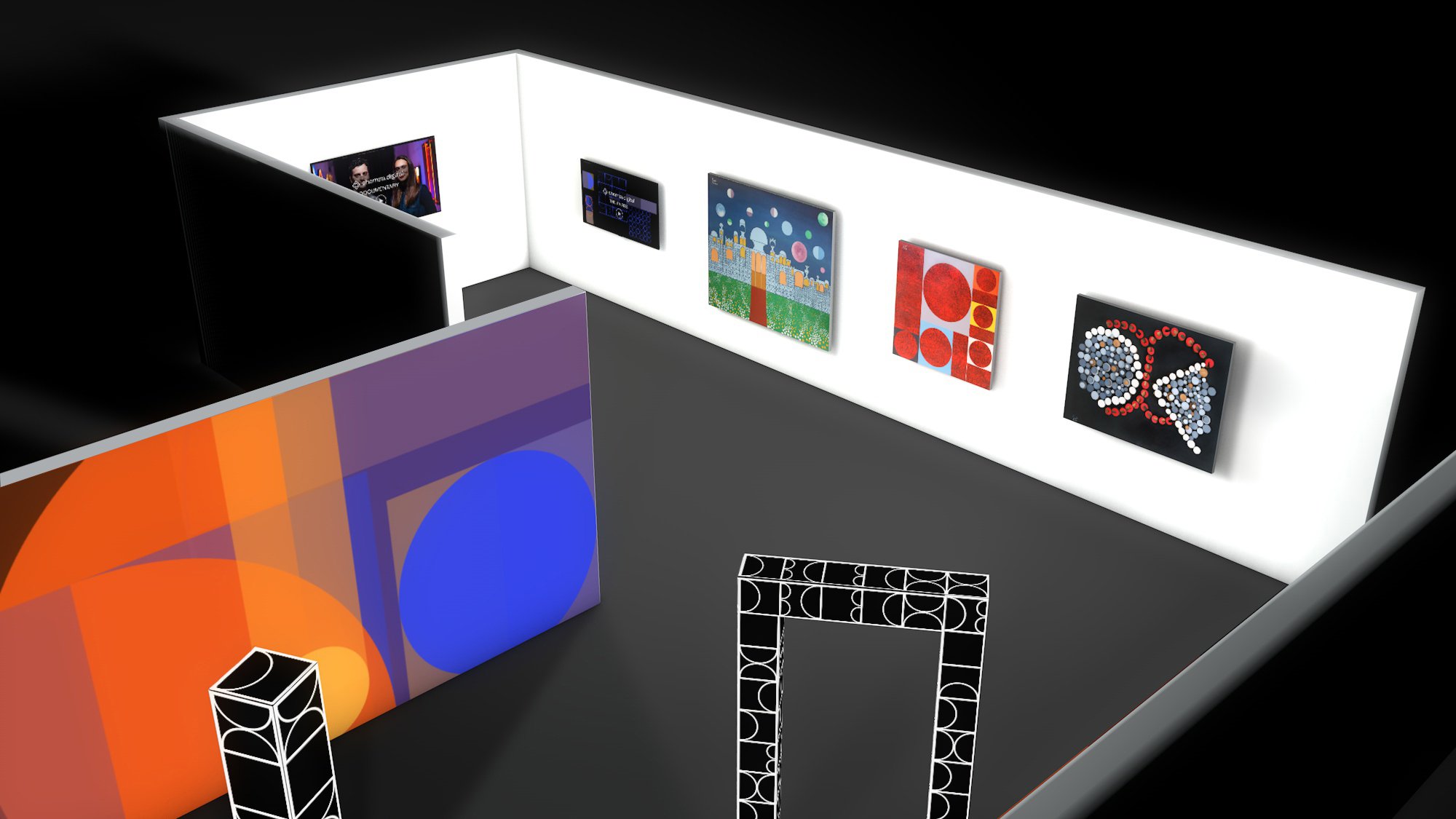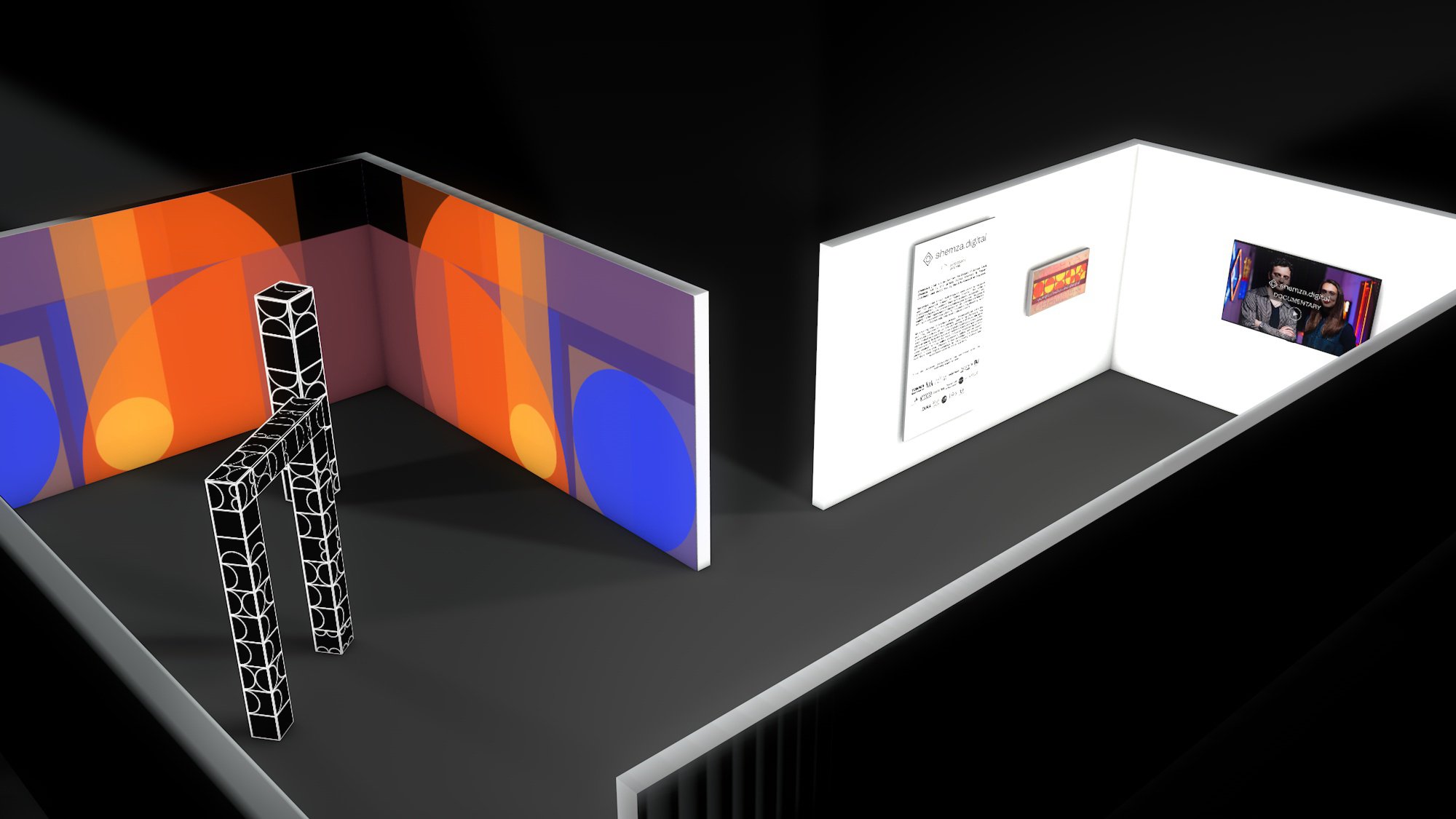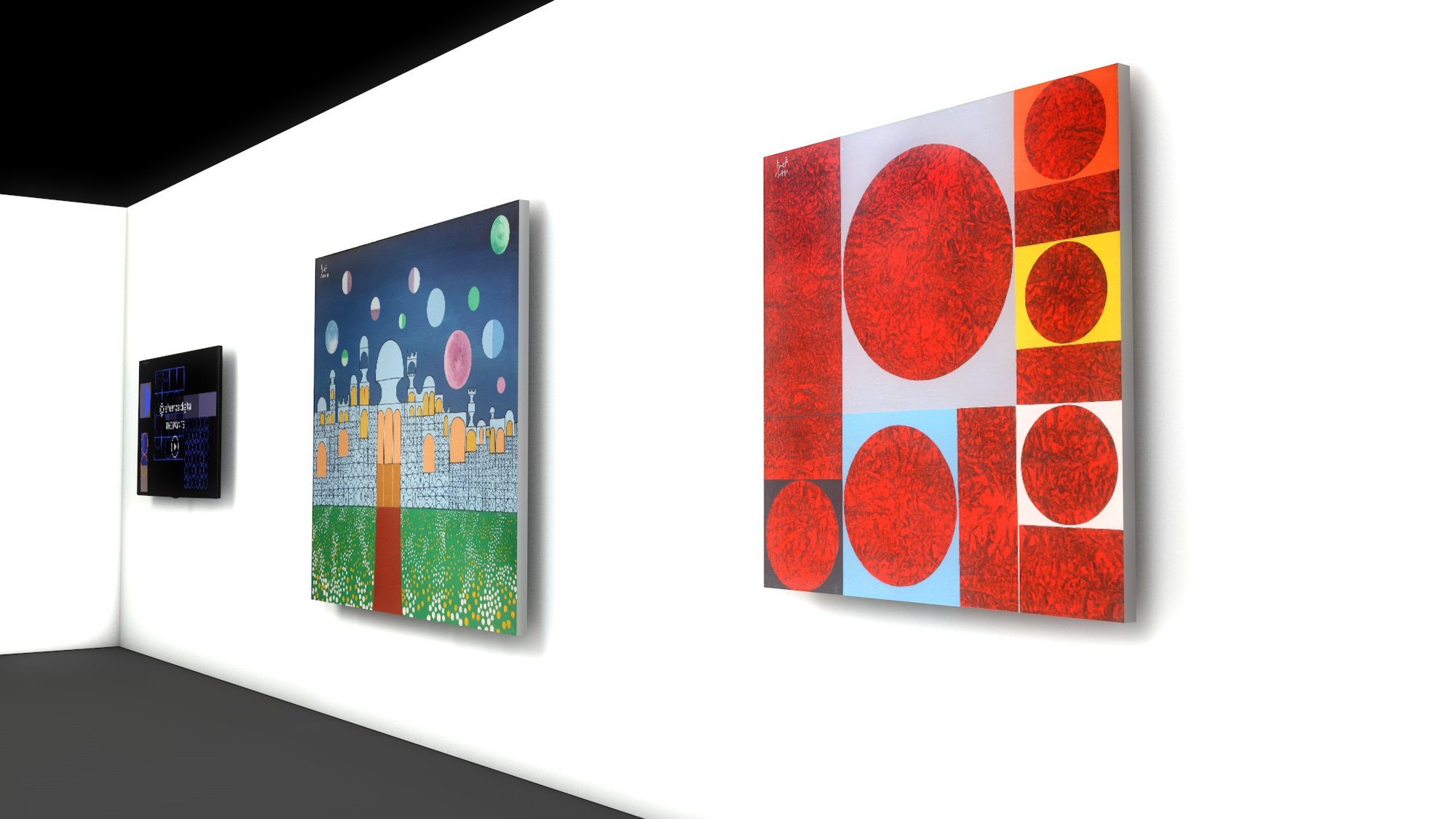shemza.digital online exhibition
30th September - 30th October 2021
shemza.digital is a project by the Estate of Anwar Jalal Shemza led by the artists Aphra Shemza & Stuart Batchelor and supported by the Arts Council of England.
The online exhibition is curated and designed by Aphra Shemza. 3D Design by Anna Sycheva. Programming by Peter Todd. View the gallery below >






















The shemza.digital project uses Anwar Jalal Shemza’s work as a starting point beside the contemporary practice of Aphra Shemza (the artist’s granddaughter) to continue Shemza’s aesthetic exploration and extend his legacy for current and future generations. The project highlights the importance of migrant artists in British Art History. It celebrates diversity aiming to step towards a decolonised artworld in an increasingly polarised political climate.
By creating this interactive project, shemza.digital asks the public to join them on this journey, generating art that is free and accessible to all. Since its launch members of the public have been invited to submit their own digital paintings created in the style of Anwar Jalal Shemza to an online archive and learn about Shemza’s work. The works made by the participants have now been curated for this online exhibition, which will be toured physically from 2022 onwards. Visitors to the exhibition are invited to contribute their digital paintings to the growing archive and watch them come to life in real time.
In the final stage of the project, we will tour a physical version of the online exhibition from 2022 onwards. We are currently in conversation with a number of organisations which will host the project. Watch this space for more information and contact us if you are interested in becoming a touring partner.
Online Exhibition Launch Recording
6.30-7.30pm, 30th September 2021
Artworks
shemza.digital
Documentary, 2021
Full HD 1080p. Featuring Aphra Shemza. Videography by Matthew Kaltenborn.
The shemza.digital project uses Anwar Jalal Shemza’s work as a starting point beside the contemporary practice of Aphra Shemza (the artist’s granddaughter) to continue Shemza’s aesthetic exploration and extend his legacy for current and future generations. The project highlights the importance of migrant artists in British Art History. It celebrates diversity aiming to step towards a decolonised artworld in an increasingly polarised political climate.
Anwar Jalal Shemza
One to Nine and One to Seven, 1962
Oil on hand dyed cloth, on mountboard and hardboard. 27 x 53cm.
Anwar Jalal Shemza arrived in London from Pakistan in 1956 to study at the Slade School of Fine Art. On arrival in the UK his Pakistani artistic achievements were not recognised and he was dismayed to hear Ernst Gombrich, his art history lecturer, dismiss all Islamic art as being purely functional. That evening Shemza went home and destroyed all the work he had created so far in the UK and decided to combine western modernism with eastern influences or as he put it ‘One Circle, One Square, One Problem, One lifetime is not enough to solve it.’ This quote is inscribed in this painting in Urdu alongside an abstract formula that Shemza used in his work for the rest of his life. In shemza.digital we use this quote as a starting point to continue his aesthetic exploration with the public, reimagining modernism in the 21st Century.
shemza.digital
Documentary (the paints), 2020
Featuring Aphra Shemza & Stuart Batchelor. Videography by Matthew Kaltenborn.
In shemza.digital Aphra Shemza and Stuart Batchelor have created an interactive digital painting application that takes aesthetic elements from Anwar Shemza’s formal artistic language and encodes them into digital paints which the viewer can use to create their own work. Each paint was based on a different style that they found prevalent in Shemza’s paintings.
The Squircle paint allows the viewer to create large bold coloured compositions with a circle inside a square.
The Weave paint is related to Anwar’s family of carpet markers and allows the viewer to paint with his more intricate motifs.
The Mosaic paint is related to Shemza’s wooden relief works, where he places wooden cylinders in a row to create his unique compositions.
Anwar Jalal Shemza
City at Morning Noon and Night, 1968-69
Oil on canvas. 78 x 93cm.
City at Morning Noon and Night, 1968-69 is from Shemza’s City Wall series. Here you can see the artist drawing on inspiration from Islamic architecture to create a city wall. The artist uses his geometric formula to create walls, archways and minarets. In this painting there is also reference to the waxing and waning of the moon and planets in the sky which relate us to the movements in the heavens - a common theme in Islamic art.
In shemza.digital we have been inspired by the woven motifs in this painting to create our Weave Paint. We have also borrowed the formation of an archway from this piece which you will see exhibited physically in the space as an interactive light sculpture.
Anwar Jalal Shemza
Square Composition 12, 1963
Oil on hardboard. 61 x 61cm.
The Square Composition series is a set of 14 paintings which are all created in a square format. In this series you can clearly see how Shemza works to combine different eastern elements with Western Modernism. In Square Composition 3 you see elements from Islamic architecture, in Square Composition 7 you see the Roman alphabet borrowed from the Bauhaus’s topography and in this work, Square Composition 12 we see a return to the simple circle and square. The texture in the painting was created by Shemza applying different layers of paint and then using newsprint to draw out a wet coat by walking over the painting in his flip flops.
In shemza.digital we were inspired by this painting to create the Squircle paint. The paint uses large blocks of colour to create intersecting compositions.
Anwar Jalal Shemza
Untitled, 1966
Wood on chipboard and matt emulsion paint. 61.5 x 76 x 11cm.
In 1961 Shemza relocated to Stafford in the West Midlands with his wife Mary Shemza and their daughter Tasveer and became an art teacher. Whilst teaching he noticed there had been some tables and chairs thrown into a skip outside the school and decided to reuse the wooden materials to create a series of wood reliefs. In Untitled, 1966 Shemza cuts different sized cylinders from these items and attaches them to the backboard to create a topographical composition.
In shemza.digital’s Mosaic paint we borrow this element to create a string of circles or squares that flow across the page when clicked and dragged.
shemza.digital
shemza.digital, 2020
Interactive digital painting application. Created by Aphra Shemza & Stuart Batchelor. Additional programming by Peter Todd.
For shemza.digital Shemza and Batchelor have created a digital painting application that is hosted online, where the public is invited to create their own digital paintings and continue Shemza’s exploration of the square and the circle. By creating this interactive artwork Shemza and Batchelor have generated art that is free and accessible to all, both in its making and its perception. Using the bespoke software hosted online, the viewer begins by clicking on the canvas to begin drawing with custom digital paints based on the elements from Anwar Shemza’s work. The viewer can alter the colours of their design and choose between the paints to create their own unique drawing. The paintings are then uploaded and stored in an online archive, which has been turned into shemza.digital #4, displaying the participants’ paintings in real time. Create your own painting and watch it appear in the installation.
shemza.digital
shemza.digital #4, 2021
Interactive real time animation. Created by Aphra Shemza. Programming by Peter Todd.
For shemza.digital #4, the viewer is invited to create their own digital painting by scanning a QR code near the work. Once the painting is submitted to the archive the viewer can watch their work come to life in the real time animation. Here the animation is displayed as a fully immersive projection placed on the three walls of the gallery.
In shemza.digital #4 Aphra Shemza and Stuart Batchelor have used participatory art as a way to highlight Anwar Shemza’s work to the public and ask them to become actively involved in artmaking by becoming artists themselves. The aim is to continue and extend the legacy of Shemza’s work and highlight the importance of migrant artists within British Art History.
The immersive installation was designed by students in Aphra Shemza’s Co-creation workshops and the artist has taken this as inspiration to create this piece.
shemza.digital
shemza.digital #5, 2021
Interactive light sculpture. Created by Aphra Shemza. 3D Design by Anna Sycheva.
In shemza.digital #5, the viewer is invited to walk through an interactive archway borrowed from Shemza’s City Wall series. Here Aphra Shemza has turned Shemza’s 2D concept which he based on Islamic architecture into something physical again that can be felt and experienced by the viewer. The ultrasonic sensors of shemza.digital #5, measure the visitor’s distance from the work and on approaching the archway the viewer’s presence makes the lights illuminate, enticing the viewer to walk through the piece. The viewers’ physical interactivity turns them into active, connected participants and this not only further develops the work but creates it: the closer they get, the more they see. Shemza.digital #5 embraces notions of performativity, dialogue and interchange.
The archway motif was designed by students in Aphra Shemza’s Co-creation workshops and the artist has taken this as inspiration to create this piece.
shemza.digital
shemza.digital #6, 2021
Interactive light sculpture. Created by Aphra Shemza. 3D Design by Anna Sycheva.
In shemza.digital #6, the viewer is invited to interact with a column borrowed from Shemza’s City Wall series. Here Aphra Shemza has turned Shemza’s 2D concept which he based on Islamic architecture into something physical again that can be felt and experienced by the viewer. The ultrasonic sensors of shemza.digital #6, measure the visitor’s distance from the work and on approaching the archway the viewer’s presence makes the lights illuminate, enticing the viewer to interact with the piece. The viewers’ physical interactivity turns them into active, connected participants and this not only further develops the work but creates it: the closer they get, the more they see. Shemza.digital #6 embraces notions of performativity, dialogue and interchange.
The column motif was designed by students in Aphra Shemza’s Co-creation workshops and the artist has taken this as inspiration to create this piece.








